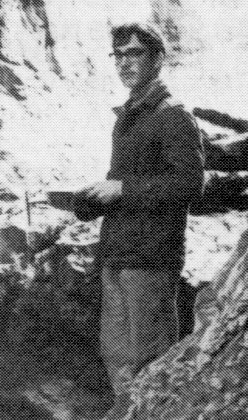|
At about eleven-thirty we found the main entrance. Taking a last look at the lights of Crickhowell, far below, we lit our lamps and entered. The entrance led straight into the main chamber - hundreds of feet deep, forty feet high and a hundred feet wide. We clambered over the boulder floor of the cave for about two hundred feet and soon found a spar leading up a hole in the roof. This we decided was the entrance to the upper series. |
|
|
Three people continued to the end of the main chamber, while one keen rock-climber climbed
through the hole in the roof. He attached a ladder and one by one we climbed up, until all six
were in the roof to find there was nowhere to go: Back in the main chamber, we decided to take the right-hand passage (from the entrance) - the left one apparently led to other entrances. It led immediately into a chamber about the size of a large room. This led into a smaller boulder chamber. After that the cave became more typically British. We grovelled for about thirty yards down a very low passage into a small chamber - entered, of course, over a small pool. Then on through more small passages and chambers. We stopped for a rest in a small rocky chamber while our leader, Dave, explored the next small passage. This passage was interesting. It was entered by a very steep slope about four feet long - on the stomach. Then there was a sharp bend to the left and the passage continued, about two feet high with three inches of water in it. Dave was thoroughly soaked getting through and found himself in a small chamber with no exit - but if he was going to get wet, everyone else was. As it happened, I was the last man. I was standing on my hands at the base of the slope, contemplating getting wet, when the word came back that Dave was a ***. With the strangest contortions imaginable, I managed to get up that slope backwards (it was impossible to turn), sat down in the chamber and waited. The first trip was on Whit Sunday evening. On the afternoon of the following Friday, we went down a wet cave - Little Neath River Cave, near Ystradfellte. The guide stated that the entrance was six hundred feet upstream of a bridge, so, clad in our hot, heavy gear we duly walked up the river - from the wrong bridge. Eventually we found a suitable set of holes in the ground. The first was dry, and so we used that. After slithering head first down a steep burrow-like hole, we squeezed through a very small gap into a small passage along which a stream flowed. Following this down, often on hands and knees, we eventually arrived in a small chamber from which several small passages emerged. The passage I explored led nowhere and, as it happened none of the other passages led anywhere either, so we retraced our steps. Thus, half an hour wasted, we tried the other entrance. This was most uninviting. At the level of the river was a foot-high slit in the bank, through which the water poured. To enter, one lay on one's stomach, in the water, and grovelled forward. I did not so much mind the warm water as the sharp rocks in odd places. The stream went into a passage about three feet high and two wide and this we followed, twisting and turning. As we descended the tunnels gradually widened, and after jumping down a small waterfall into a pool, no more crawling in water was necessary. Shortly we came into a system of passages and chambers with some of the most beautiful formations I have ever seen. Thin, pale stalactites hung from the roof. These were hollow and translucent. Large beehive structures formed on butresses, like petrified waterfalls. In places, misshapen stalagmites were forming in mud. They were like petrified jellyfish, with a red spot in the middle and clear jelly spreading round. Finally, we entered the sand cavern. The stream meandered around vast banks of silt under a high roof. Formations lined the walls. At the far end of the cavern, the stream from another cave system flowed in from a hundred foot sump; we did not attempt it. The caves continued, through larger and larger caverns and chambers for about a mile, but we were already half a mile down and were running out of time. So we returned through smaller passages and warmer water. In some chambers it was stiflingly hot. As last, we went through the final squeeze into the glorious sunshine, and fresh air. |
||
